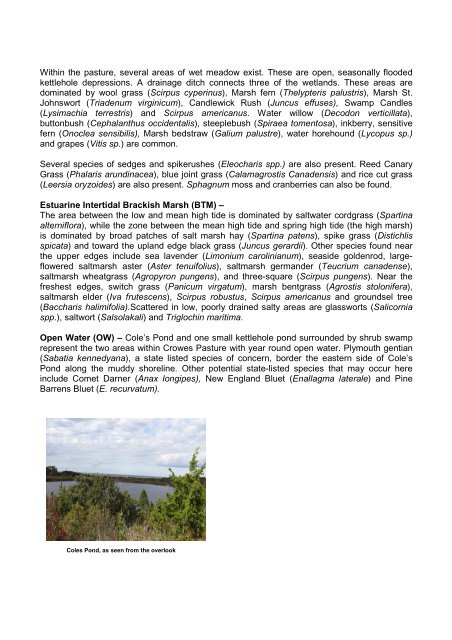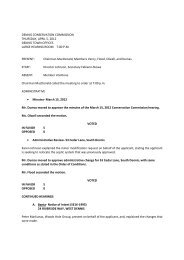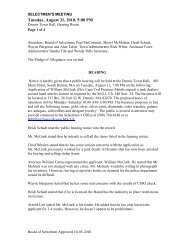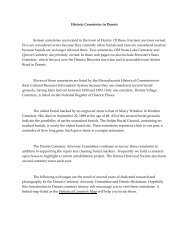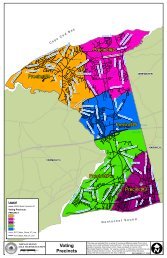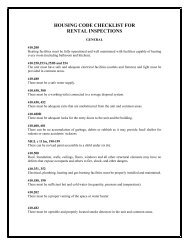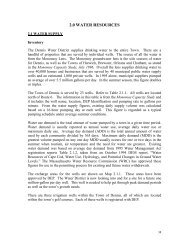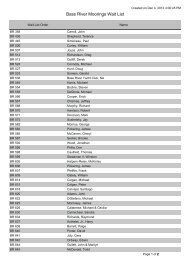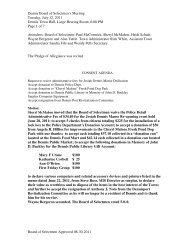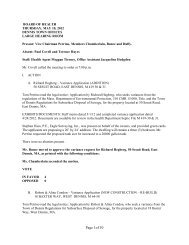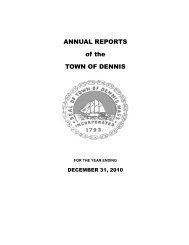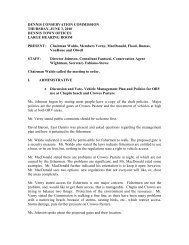Stewardship Plan - the Town of Dennis
Stewardship Plan - the Town of Dennis
Stewardship Plan - the Town of Dennis
You also want an ePaper? Increase the reach of your titles
YUMPU automatically turns print PDFs into web optimized ePapers that Google loves.
Within <strong>the</strong> pasture, several areas <strong>of</strong> wet meadow exist. These are open, seasonally flooded<br />
kettlehole depressions. A drainage ditch connects three <strong>of</strong> <strong>the</strong> wetlands. These areas are<br />
dominated by wool grass (Scirpus cyperinus), Marsh fern (Thelypteris palustris), Marsh St.<br />
Johnswort (Triadenum virginicum), Candlewick Rush (Juncus effuses), Swamp Candles<br />
(Lysimachia terrestris) and Scirpus americanus. Water willow (Decodon verticillata),<br />
buttonbush (Cephalanthus occidentalis), steeplebush (Spiraea tomentosa), inkberry, sensitive<br />
fern (Onoclea sensibilis), Marsh bedstraw (Galium palustre), water horehound (Lycopus sp.)<br />
and grapes (Vitis sp.) are common.<br />
Several species <strong>of</strong> sedges and spikerushes (Eleocharis spp.) are also present. Reed Canary<br />
Grass (Phalaris arundinacea), blue joint grass (Calamagrostis Canadensis) and rice cut grass<br />
(Leersia oryzoides) are also present. Sphagnum moss and cranberries can also be found.<br />
Estuarine Intertidal Brackish Marsh (BTM) –<br />
The area between <strong>the</strong> low and mean high tide is dominated by saltwater cordgrass (Spartina<br />
alterniflora), while <strong>the</strong> zone between <strong>the</strong> mean high tide and spring high tide (<strong>the</strong> high marsh)<br />
is dominated by broad patches <strong>of</strong> salt marsh hay (Spartina patens), spike grass (Distichlis<br />
spicata) and toward <strong>the</strong> upland edge black grass (Juncus gerardii). O<strong>the</strong>r species found near<br />
<strong>the</strong> upper edges include sea lavender (Limonium carolinianum), seaside goldenrod, largeflowered<br />
saltmarsh aster (Aster tenuifolius), saltmarsh germander (Teucrium canadense),<br />
saltmarsh wheatgrass (Agropyron pungens), and three-square (Scirpus pungens). Near <strong>the</strong><br />
freshest edges, switch grass (Panicum virgatum), marsh bentgrass (Agrostis stolonifera),<br />
saltmarsh elder (Iva frutescens), Scirpus robustus, Scirpus americanus and groundsel tree<br />
(Baccharis halimifolia).Scattered in low, poorly drained salty areas are glassworts (Salicornia<br />
spp.), saltwort (Salsolakali) and Triglochin maritima.<br />
Open Water (OW) – Cole’s Pond and one small kettlehole pond surrounded by shrub swamp<br />
represent <strong>the</strong> two areas within Crowes Pasture with year round open water. Plymouth gentian<br />
(Sabatia kennedyana), a state listed species <strong>of</strong> concern, border <strong>the</strong> eastern side <strong>of</strong> Cole’s<br />
Pond along <strong>the</strong> muddy shoreline. O<strong>the</strong>r potential state-listed species that may occur here<br />
include Comet Darner (Anax longipes), New England Bluet (Enallagma laterale) and Pine<br />
Barrens Bluet (E. recurvatum).<br />
Coles Pond, as seen from <strong>the</strong> overlook


